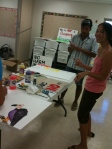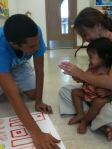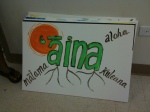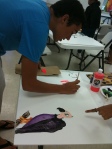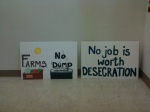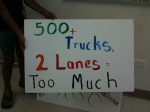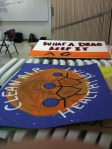Blog
News, updates, finds, stories, and tidbits from staff and community members at KAHEA. Got something to share? Email us at: kahea-alliance@hawaii.rr.com.
Farms, Not Dumps for Wai'anae Coast
Today, despite overwhelming community support for protecting local farm lands, developers are pushing Honolulu Councilmembers to approve a “purple spot,” a new industrial zone in the middle of green Lualualei Valley on the Waianae Coast.
Land Use Commissioners Approve Development on O'ahu Prime Ag Lands

From our friends and ‘ohana at Sierra Club Hawai’i Chapter:
In a 7-1 vote last week, the State of Hawaii Land Use Commission approved Castle & Cooke Homes Hawaii, Inc.’s proposed reclassification 767 acres of farmland to the urban district. Castle & Cooke proposes to build thousands of new homes and a medical complex at Koa Ridge between Mililiani and Waipio.
The Sierra Club, Hawaii Chapter, as a party to the case, asked the Commission to deny the reclassification because the project would adversely impact an already congested highway and prime agricultural lands.
“Castle & Cooke’s plan for Koa Ridge is the epitome of urban sprawl,” said Robert D. Harris, Director of the Hawaii Chapter of the Sierra Club. “When we’re importing 85 to 90% of our state’s food, it’s absurd to pave over land that has been consistently and profitably providing food for O`ahu.“
The Sierra Club brought expert witnesses before the Commission earlier in the year that testified about the detrimental impacts of losing nearly 800 acres of some of the best farmland in the state. Even Castle & Cooke’s own expert noted that the Koa Ridge proposal would develop approximately 5% of O`ahu’s remaining prime farmland (soil rated “A” and “B” under the ALISH system). The State Department of Agriculture testified that fifty percent of O`ahu’s prime farmland had been paved over in the past fifty years.
“Diversified agriculture increased 475% between 1990 and 2004,” said Harris. “There has been a resurgence of interest in eating in a local and sustainable manner. But if we want further growth in agriculture, we need to have the farmland.”
There are other anticipated demands on farmland, like growing bioenergy, which will require thousands of acres of farmlands with a ready supply of irrigable water. “It’s a slippery slope,” Harris continued. “As we develop more agricultural land, it drives up the cost for the remaining parcels and makes it more difficult for other farmers to grow local.”
One knowledgeable scientist testified that University of Hawaii faculty researchers are concerned O`ahu will lose its capability to feed itself unless large farmlands like Koa Ridge were preserved. “We’re just one hurricane away from starving,” said Harris. “We’re dangerously reliant on food from being shipped into O`ahu. Preserving and growing agriculture in the State is a matter of basic food security.”
Other witnesses testified about the surplus of land already proposed for development in Central O`ahu and the negative impact of increased traffic on folks traveling along the H-1 corridor. The state’s traffic expert testified that the peak “rush hour” traffic could extend bottlenecks on the H-1 freeway potentially from as early as 5:00 am in the morning and similar hours in the evening. The H-1 already has a grade “F” designation, the worst service traffic level.
The Sierra Club believes that the housing demand can be met without sprawling on more agricultural lands in Central O`ahu. Existing urban areas in Central O`ahu, such as Wahiawa and Waipahu, should be redeveloped. Further, over 13,000 units of housing have already been approved on over 1500 acres of agricultural land for new growth in Central O`ahu. Although the developer claims that new land must be developed to meet growing demand, population in some surrounding Central O`ahu communities actually decreased between 1990 and 2000.
“O`ahu is hitting some real limits to growth. We need to start redeveloping built areas instead of paving our finite and precious farmlands,” said Harris. “Particularly with plans for over 13,000 new housing units already on the books for Central O`ahu, it’s outrageous that the Commission would authorize new development of the best agricultural lands in the state.”
For more information, you can check out Sierra Club on the web at http://www.sierraclubhawaii.com/media.php
And here’s coverage from back in May of part of the LUC hearing on Koa Ridge: http://the.honoluluadvertiser.com/article/2010/May/21/bz/hawaii5210320.html
Ahi Feedlot Abandons Ship!

Mahalo to all who took action in the last few months, asking the Army Corps of Engineers to hold a public hearing on a permit to allow Hawai’i Ocean Technology, Inc. (HOTI) to build a proposed 247-acre ahi tuna feed lot off the Kohala Coast. 100% of the feed for this project would be imported from fisheries in places like Peru, and 90% of the tuna they feedlot will be exported to Japan and the continental U.S. (Does this sound like local food sovereignty to you? Not so much.)
Last week, we got news that HOTI has withdrawn their permit application. They may still be looking to do a smaller one-cage “experimental” operation. We’ll keep you updated. But for now, count this is a victory for the ocean. Mahalo for your action! Thanks to you, we’re a little closer today to a collective vision of food sovereignty and a functioning food system for Hawai’i. To learn more or to join the hui in support of pono aquaculture, you can go to www.ponoaqua.org
Signs of Aloha Aina
From Marti:
We had our first sign-making party in the “Keep Waianae Country” effort. We are getting ready for the Land Use Commission to visit the parcel of farmland that Tropic Land proposes to turn into an industrial park. Their visit happens on Wednesday August 18th at 1:30 pm.
Want to join us? We’ll be on Farrington Highway where it intersects with Lualualei Naval Access Road and with Hakimo Road at 1:00 pm.
Can’t make it, but still want to participate? Then make a sign in support of keeping Waianae country, take pictures of you and your friends holding the sign, and then send the pictures to us at miwa(at)kahea.org. We’ll make sure the LUC sees it.
And if you live along the navy road or Hakimo road, then hang a sign on your fence where everybody can see it. We’ll be passing out the beautiful signs we made next week. Let us know if you want one.
Big Mahalo to everyone who came out to help us make signs. It was a lot of fun. And who knew Tyler would turn out to be poster-painter extraordinare… in addition to top ace legal intern?! Finger painting ain’t just for kids anymore!
Spreading the Word
From Shelley:
This weekend we hosted our fourth Environmental Justice Bus Tour–this time with an added stop at the Farmer’s Market. Mahalo to everyone who came out to learn more about Wai`anae! We had a great mix of people hailing from far and wide. Groups represented were Nakem Youth (from Kalihi), CEJE, Hawai`i Farm Union, the Hawai`i Independent, and the Lawai`a Action Network–as well as some community members. Special shout out to Nakem Youth for blogging your reflections of the bus tour! Check it out! Here is some of their powerful testimony:
Mark: “We gotta change our public perception of Waianae. I didn’t know about the agricultural lands, it was beautiful to see and very different from the way the mainstream media presents it.”
Sonny: “I have family members who live in Waianae and I fear for their lives. There are many kids who run around and I don’t want them getting hit by trucks…”
Rochie: “I live in Waianae I didn’t know what was really happening. The dumpsite was all blocked and I thought it was for housing development. We need more transparency from these companies and the state.”
Powerful! More at their blog. Mahalo to Nakem Youth member, Mark Fiesta, also for putting up such beautiful photos of the event. Here’s a link to his blog. Solidarity is a beautiful thing. ![]() Mahalo to everyone for coming, if you are interested in joining our next tour, it is on August 28th. Email shelley@kahea.org for more information.
Mahalo to everyone for coming, if you are interested in joining our next tour, it is on August 28th. Email shelley@kahea.org for more information.
You Don't Know What You Don't Know
From Shelley:
This past Saturday, a small group of determined “door knockers” set out to give a heads up to residents on Hakimo Road in Lualualei about a proposed industrial park planned in their neighborhood of small farms and homes. Of all the 30 or so people we talked to, not a single person had heard about or been notified of these plans to industrialize the valley.
I have to admit, I was nervous going into a rural community knocking on doors, but everyone was really nice. They were thankful we came by because otherwise they would have never known that an industrial park is being proposed. Of course it helped being with Aunty Alice Greenwood, who everyone knows, and it felt good to hear people express their gratitude for her determination to fight. Those kind words are important to me because I’m always wary to get into other people’s business–knowing that we have their blessing and request to move forward tells me that we’re on the right path!
One thing that really tugged at my heartstrings was meeting more than one family that lost their farm in the Kalama Valley evictions in the 1970s. These families relocated to Wai`anae and 35 years later are again facing the displacement of their family business and rural lifestyle- -from some of the same developers!
For rural Hakimo Road, the developer’s own numbers cites an additional 522 trucks an hour during peak hours! I don’t even know how that is possible, but that figure comes directly out of their EIS report. The only legal access to the property is rural Hakimo Road. (Though the proposed site is actually on Lualualei Naval Road, this private road requires an agreement with the Navy for regular access. Our calls to the Navy have confirmed that no such agreement exists!)
If you have ever been on Hakimo Road you will know that 1) there are NO sidewalks, 2) it is narrow and winding, and 3) is already dangerous at the current traffic level, let alone with the addition of over 500 big trucks! One resident pointed out to us, “Go walk up and down, you’ll see flowers at almost every turn marking all the accidents!”–it was so sad, she was right. There’s a preschool on this road and many residents are worried about the health and safety of the kamalii (little ones) who go to school there.
Can you imagine if this was going on in your neighborhood? You can sign here to stand in solidarity with this community!
Aina Hoola o Mailikukahi
From Shelley:
Two weeks ago I attended a Food Sovereignty Conference in Waimanalo. I was a little bummed because I was on the planning committee, working on behind the scenes stuff, but in retrospect I can’t complain! Went to some awesome workshops and met some incredible people.
The first day was devoted to the Youth Delegation to learn more about the concept of Food Sovereignty and about the leadership qualities it will take to turn Hawai`i’s food dependency around.
The next day was open to the general public and after an opening plenary we embarked on huaka`i (field trips) to various farms and other food systems in the area. The sites were UH SOFT Garden, Mala Laulima, Olomana Gardens, Aina Aloha o na Limahana and an on-site Aquaponics demonstration. That was a HOT day, I got burnt. I went to Mala Laulima, an organic garden behind Waimanalo Elementary School.
The last and final day was full of workshops to attend. I attended `Ai Pono, Local Pollinators, and Native Limu. It was awesome. `Ai Pono was Uncle Herbert Hoe and his daughter Aunty Tammy. They are working hard to incorporate fresh and traditional foods into school lunches! This past year they only served at Hakipu’u Learning Center (a charter school run by their family), but next year they are expanding to 7 schools! Exciting! ![]() They said the kids get mountain apple in their fruit salad–so lucky! They use `ulu from their yard, and are able to buy produce from nearby farmer’s (they’re from Waiahole). Aunty’s message: “It CAN be done!”
They said the kids get mountain apple in their fruit salad–so lucky! They use `ulu from their yard, and are able to buy produce from nearby farmer’s (they’re from Waiahole). Aunty’s message: “It CAN be done!” ![]() So inspiring.
So inspiring.
The session on Local Pollinators was so awesome! They brought different kinds of honey for us to try–so ‘ono, as well as a display bee colony. Did you know that Princess Bernice Pauahi Bishop was the first one to introduce honeybees to Hawai`i? We learned all about how different kinds of bees pollinate different kinds of plants. Here’s one of the coolest images they used. The top is a cucumber that had been “visited” (supposed to be by a bee, but this might have been hand pollinated) only a few times, next to one that was “visited” many times. Night and day!

the power of pollination!
Bees are so important! I learned of a new deleterious effect of pesticides and herbicides–they can kill bees! The presenters were saying that bee folks think that this is a contributing factor to the decline in wild bee populations. Another reason to go organic! ![]() The other cool thing I learned was that we have native honeybees!
The other cool thing I learned was that we have native honeybees!
The bummer thing is that the other day I saw this article about how they are being considered for federal protection because they’ve become extremely rare. They are endemic, not found anywhere else in the world! The article said that they may be getting pushed out by honeybees, but the presenters said that studies in Brazil said that honeybees are not known to be invasive, but instead pollinated enough plants so that native bees continued to have habitat and food. Not sure which one is the case in Hawai`’i.
The last workshop I went to was on Native Limu–wow, so much knowledge! Uncle Henry Chang-Wo shared about how he can look at the limu on the shoreline to tell what kind of fish are present in the area–because certain fish only eat certain limu. Wow! He also shared about how some kinds of limu can only grow in areas where there is fresh, clean water outflow–if you see that one on the shore you know that the watershed of the area is somewhat still intact. He explained that limu was to Hawaiians what herbs and spices are to other cultures. I could go on and on, but really, if you ever get a chance to meet Uncle Henry, be ready to learn!
Mahalo to all the presenters, hosts, and participants–see you all next year! ![]()

